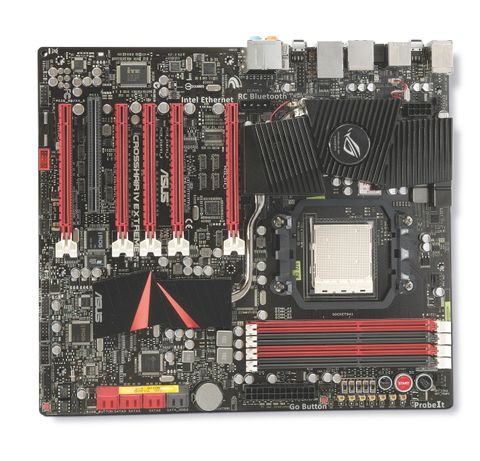Why you can trust TechRadar
Compared to any of the other motherboards we've looked at carrying Lucid's HydraLogix 200 chip lately, Asus' Crosshair IV Extreme is packed to the gills with features both visible on the PCB and in the BIOS – as you would expect from a board carrying the RoG label.
Unlike MSI's 870A Fuzion, which uses an AMD 870/SB810 chipset combination to keep the price down, Asus have firmly aimed the Crosshair IV Extreme at the high-end, fitting it with a flagship AMD 890FX/SB850 chipset combination.
When it comes to how the board performs, it's pretty impressive. Not quite as fast as Asus's 'pure' 890FX board, the Crosshair IV Formula, but it's pretty close in terms of overall performance. And with all those graphics slots, the Crosshair IV Extreme is far more flexible when it comes to graphics setups too.
In a pure Crossfire setup using the 890FX chipset you won't need to worry about frame rates, but when it comes to using the Hydra chipset in SLI there are still some issues. Hopefully, these will be ironed out with subsequent driver releases.
In mix-and-match mode, the performance shows a good deal of promise.

Since the Crosshair IV Extreme is a member of the RoG gang, you shouldn't be surprised to find extra 'goodies' placed around the board and a very interesting group of these appear on the top-right-hand edge, next to the four DDR3 DIMM slots (which support memory speeds up to 2000MHz). Alongside the large start button (which lights up) and buttons for resetting, OC and Core Unlocker are seven Probelt points.
These points enable you to measure the true voltages being used by CPU, memory, chipset bridges and so on when overclocking by using a multimeter directly, or via the extension cables that are included in the box. Next to these sit five small on/off switches, which turn the PCIe slots on and off.
So if you're feeling lazy and can't be bothered to remove a card, you can simply switch the slot it's sitting in off.
Any motherboard carrying a RoG label pretty much guarantees that not only will the board be crammed with features, but the box bundle will be pretty impressive too.
The Crosshair IV Extreme doesn't disappoint and opening the box shows real skill in the art of packing of nothing if else.
The impressive list includes a RoG Connect Bluetooth module, a couple of thermal sensors, the really useful Asus Q Connector (extension plugs for the front panel case leads, so no more fiddling about), a USB RoG cable, an I/O plate with single eSATA and dual USB 2.0 ports, two 3GB/s SATA cables and three 6GB/s SATA cables.
We Liked
The Crosshair IV Extreme is a well put together board with plenty of features to keep the high-end enthusiast or hardcore overclocker happy, but this should come as no real surprise as it's what Asus's RoG range is all about.
The combination of AMD's 890FX/SB850 chipset combination and Lucid's Hydra technology together with the multitude of PCIe graphics slots make for an interesting addition to the Asus high-end motherboard collection.
We disliked
There's not much to dislike about Asus' Crosshair IV Extreme apart from the price tag. But since Asus hasn't compromised with any of the hardware, the high price was almost a given.
Verdict
The Asus Crosshair IV Extreme is a mightily impressive board aimed at more of a niche market than the recent MSI Lucid boards we've looked at. It'll be interesting to see how well the Lucid technology goes down with the enthusiasts and/or overclockers this time around.
Follow TechRadar Reviews on Twitter: http://twitter.com/techradarreview
Current page: Asus Crosshair IV Extreme review: verdict
Prev Page Asus Crosshair IV Extreme review: Benchmarks
